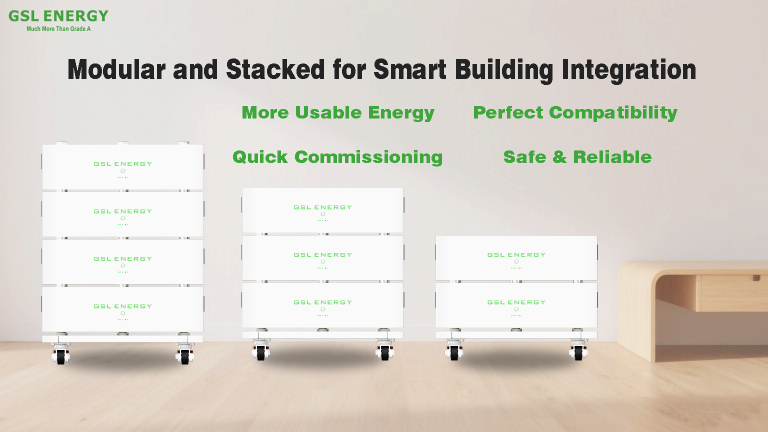Commercial Energy Storage: Unlocking New Opportunities
How Lithium-Based Solutions Are Reshaping Industrial and Business Energy Strategies
As the global energy scenario develops, commercial energy storage has turned into a foundation of modern infrastructure. Enterprises in various sectors are looking for more intelligent and resilient methods to handle electricity, cut costs, and shift to renewable energy. At the core of this change is a new generation of lithium-based energy storage solutions—effective, expandable, and designed to fulfill the increasing demands of industrial and commercial settings. From large - scale battery banks to portable backup systems, the newest technologies are not just enabling operational resilience but creating new revenue streams via grid services and energy arbitrage.
The Rise of Industrial-Scale Storage
One of the Gslenergy battery’s leading solutions revolutionizing this space is the Industrial Commercial Energy Storage Battery, often referred to as a BESS (Battery Energy Storage System). These large-capacity systems—often ranging from 100 kWh to over 1 MWh—are the backbone of microgrids and smart industrial zones. They offer rapid discharge capabilities, long cycle life (often exceeding 6000 full charge-discharge cycles), and seamless integration with renewable generation. Factories, data centers, and remote mining operations are increasingly adopting these robust systems not just for energy security, but to participate in frequency regulation and demand response markets.
Wall-Mounted Storage for Scalable Buildings
In contrast to the scale of BESS units, Power Wall Storage Batteries are compact and wall-mounted, making them ideal for medium-scale commercial environments like office buildings, clinics, or multi-unit residences. These batteries typically store between 5 to 20 kWh per unit and can be combined modularly to support higher energy needs. Their appeal lies in a plug-and-play architecture that simplifies installation, while offering key features such as load shifting and uninterruptible power supply. Thanks to advanced Battery Management Systems (BMS), power walls also support remote monitoring and integration with PV systems, enabling complete solar+storage solutions in tight urban spaces.

Specialized Systems for Telecom Infrastructure
For highly specialized applications such as telecommunications infrastructure, the Telecom Energy Storage System (TESS) has become a standard. Built for high reliability in fluctuating environmental conditions, these batteries are compact yet durable, often operating reliably in temperatures ranging from -20°C to 60°C. TESS units are designed to ensure consistent DC power to remote base stations, especially where grid supply is erratic or unavailable. In regions where cellular networks are critical to emergency communications, TESS units act as the invisible support system that keeps networks alive during blackouts.
High-Voltage Systems for Demanding Applications
High Voltage LiFePO4 batteries are another crucial innovation in commercial storage. With voltage ratings often between 200V to 1000V, these batteries deliver energy density and reliability for high-load applications such as commercial solar farms, hospital backup systems, or EV charging hubs. Unlike conventional lithium-ion batteries, LiFePO4 (lithium iron phosphate) chemistry offers superior thermal stability and safety—a non-negotiable in densely populated commercial spaces. Coupled with 6000 to 8000 cycle lifespans and high round-trip efficiency (above 95%), these systems are rapidly becoming the go-to solution for institutions seeking long-term ROI from their energy infrastructure.
Modular and Stacked for Smart Building Integration
The rise of modular, space-efficient designs is best exemplified by the Stacked Lithium-Ion Battery. These systems, composed of stackable 5 to 10 kWh units, can be configured vertically to save floor space while achieving large storage capacities. Their flexibility makes them ideal for indoor storage rooms, smart buildings, and mobile container systems. With each module featuring its own BMS and thermal controls, they provide granular control over energy distribution, making energy management more adaptable and data-driven.

Smarter Inverters, More Efficient Energy Utilization
Even fundamental components like inverters are undergoing innovation. The current commercial Inverter Series comes with multi - MPPT designs for large PV arrays, bidirectional current flow for both charging and discharging, and smooth grid/off - grid switching. When combined with high - performance batteries, contemporary inverters allow for real - time monitoring, adaptable charging algorithms, and advanced fault detection—all of which enhance system lifespan and save energy costs.
Small Systems with Significant Impact
Smaller systems haven't been overlooked. For auxiliary commercial functions such as telecom backup, smart lighting, or security systems, 12V and 24V Lithium Batteries still provide lightweight, efficient power. Despite their small size, these units offer outstanding deep - cycle performance, stable voltage output, and compatibility with a wide variety of low - voltage equipment. Their reliability makes them a vital part of the broader commercial power resilience ecosystem.
The LiFePO4 Edge
Throughout all these technologies, one thing remains unchanged: the preeminence of LiFePO4 chemistry. This material, preferred for its long cycle life, low thermal risk, and environmental friendliness, has become the core of almost all commercial - grade energy storage systems. Most modern batteries now have lifespans of 3500 to 7000+ cycles and retain over 80% of their capacity after years of heavy use—significantly outperforming older lead - acid or nickel - based alternatives.
A Future Based on Smart Energy
In summary, commercial energy storage is no longer a niche market—it is the essential infrastructure for everything from production lines to emergency response teams. The combination of advanced lithium technology, intelligent power management, and modular system architecture has opened the door to solutions that are safer, more expandable, and far more effective. As demand continues to grow and grid reliability becomes increasingly unreliable, the companies that invest in the right storage technologies now will be the ones that dominate the future energy economy.


